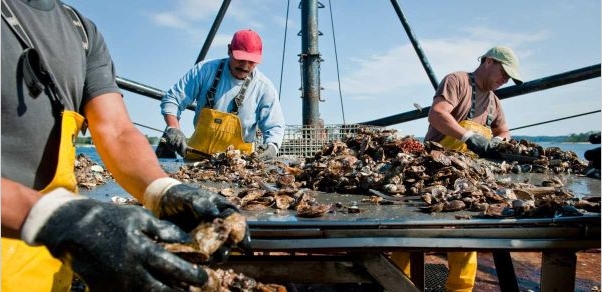Stony Brook, NY, December 9, 2011 - As reported in mid-November 2011 by WSHU Public Radio's Charles Lane, the toxic algae growth known as red tide has become more common in and around Long Island sound. It makes shellfish poisonous. The problem is, it's hard to spot red tide before it's too late. One researcher thinks he has a solution.
The process that warns people and keeps them from eating bad clams and oysters is laborious. New York's Department of Environmental Conservation has to sink mussels into the water and, every so often, bring them up, dissect them and measure the toxicity. All of this can take up to two weeks. Only then can they shut down a shellfish bed.
"It may well be, or it likely is, that there are other shellfish in that ecosystem that are already toxic and that can poison people." Dr. Christopher Gobler has a way to speed this up. He is an associate professor in the School of Marine and Atmospheric Sciences at Stony Brook University.
Right now, the DEC tests only a few sites at at time. But, by this spring, Gobler, along with the DEC and the National Oceanic and Atmospheric Administration, plans to have hundreds of tests sites up-and-running all over Long Island.
"Remote devices deployed in the water continuously make measurements of water quality," says Golber. Scientists still don't know much about red tide. But, when Gobler's testing sites first detect this microbe responsible for it, they'll have advanced warning that the tide is coming, which will hopefully keep people from eating bad shellfish.

Oct. 5, 2011 - Crew of the fishing boat Waldron B. sort hundreds of fresh oysters pulled from
the Long Island Sound in the waters off Oyster Bay and Bayville. Image by Steve Pfost for Newsday
Eating shellfish tainted with toxins from these marine algae species can lead to paralytic shellfish poisoning and diarrhetic shellfish poisoning in humans.
"This work will enable consumers of New York shellfish to remain confident in the quality of the local seafood they enjoy and enable New York to safeguard a commercial industry generating $19 million per year," said a NOAA representative, as reported in a recent
Newsday article. "The project will investigate advanced monitoring technologies and early-warning methods to help New York respond to a growing toxic algae bloom problem that is a threat to public health and jobs that depend upon harvesting and marketing of seafood."
For more on the appearance and effects of toxic algal blooms along Long Island's north shore, check out the "Red tide hard to spot early"
audio clip from WSHU radio (.mp3;
click here), see the recent
NOAA/NYSG press release (
click here), and the related
Newsday article "Stony Brook gets algae bloom study funds" (pdf;
click here).
New York Sea Grant is one of 32 university-based programs under the National Sea Grant College Program of the National Oceanic and Atmospheric Administration (NOAA), a cooperative program of the State University of New York and Cornell University. The National Sea Grant College Program utilizes this network of the nation's premier universities in conducting scientific research, education, training and extension projects designed to encourage science-based decisions about the use and conservation of our aquatic resources.